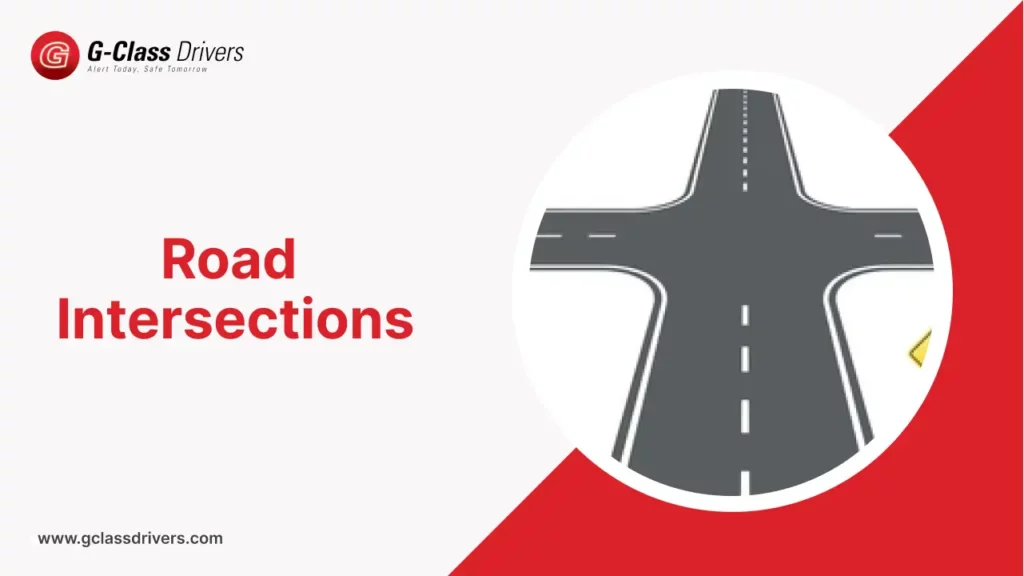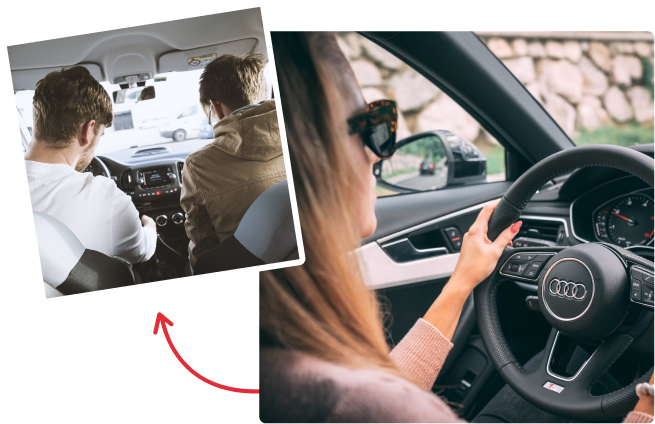Intersections are essential parts of the road network where two or more roads meet. They can vary in structure and control methods, but no matter the type, intersections are critical points that demand heightened attention from drivers, cyclists, and pedestrians. Understanding the different types of intersections and the right-of-way rules is vital to avoid collisions and ensure smooth traffic flow.
In this article by G-Class Drivers School, we’ll explore major types of road intersections and how to deal with them safely. Further more we will explore key right-of-way rules every driver should know.
Types of Road Intersections
Intersections can be categorized based on their structure and the way they are controlled. Here are the most common types:
Four-Way Intersection
A four way intersection is where two roadways cross each other creating four entry and exit points. These are common in urban areas and are usually controlled by stop signs or traffic lights.
T-Intersection
A T-intersection occurs when one roadway ends and connects perpendicularly with another road forming a “T” shape.
Y-Intersection
A Y-intersection involves three roadways connecting in a “Y” shape, where none of the roads continue straight across.
On-Ramp
An on-ramp is a one way roadway designed to allow vehicles to enter highways or turnpikes.
Off-Ramp
An off ramp enables vehicles to exit from highways or turnpikes onto other roads.
Traffic Circle
A traffic circle is a circular intersection where vehicles travel around a central island to reach different roads. Typically found in residential areas they are smaller than roundabouts.
Five-Point or More Intersection
An intersection where more than two roadways cross or connect, often complex and controlled by traffic signals.
Driveway Intersection
A driveway is a private access road connecting to a public trafficway but not meant for public transport flow.
Railway Grade Crossing
This is where a roadway crosses train tracks at the same level (grade), requiring vehicles to stop for oncoming trains.
11. Unknown Intersection
When the intersection type is not identified, typically need an explanation in reports.
Controlled vs. Uncontrolled Intersections
Let’s explore the difference between controlled vs uncontrolled intersections:
Controlled Intersections
Controlled intersections are equipped with traffic control devices such as traffic lights, stop signs, or yield signs to manage vehicle and pedestrian flow.
There are different types of Controlled Intersections like:
Traffic Light Controlled:
- Green light: Proceed if safe.
- Yellow light: Prepare to stop unless it’s unsafe to do so.
- Red light: Come to a complete stop. Right turns on red may be allowed if no signs prohibit it.
Stop Sign Controlled:
- At a four-way stop vehicles proceed in the order they arrived. If arriving simultaneously, the vehicle on the right goes first.
- At two-way stops vehicles on the stop-sign-controlled road must yield to traffic on the through road.
- Left-turning vehicles must yield to oncoming traffic going straight.
Yield Sign Controlled:
Slow down or stop if needed and proceed only when safe.
Blocked Intersections:
Never enter an intersection if traffic prevents you from passing through completely.
Uncontrolled Intersections
Uncontrolled intersections lack signs or traffic lights and are usually found in low-traffic, residential areas.
Right-of-Way at Uncontrolled Intersections:
- First come, first go: The vehicle that arrives first has the right-of-way.
- If arriving simultaneously, the driver on the left must yield to the driver on the right.
- Always slow down and scan for pedestrians, cyclists, and other vehicles.
Traffic Circles vs. Roundabouts
The difference between circles vs Roundabouts is given below:
Traffic Circles
- Smaller circular intersections, common in residential zones.
- Traffic inside the circle has the right-of-way.
- Enter to the right, travel counter-clockwise, and exit to the right.
- If arriving simultaneously with another vehicle, yield to the vehicle on the right.
- Treat like uncontrolled intersections if no signs are present.
Roundabouts
- Larger and often multi-lane circular intersections.
- Designed to improve traffic flow and reduce serious crashes.
- Yield to traffic already in the roundabout and pedestrians crossing at marked crosswalks.
- Enter to the right and travel counter-clockwise.
- Do not change lanes inside a roundabout.
- Signal right when you are about to exit.
Read Also: Roundabout Rules for Safe Driving in Canada
Road Intersections Rules for Yielding the Right-of-Way
Understanding when to yield is critical for safety and legal compliance:
- At uncontrolled intersections, yield to vehicles already in the intersection or approaching from the right.
- When turning left, yield to oncoming traffic and pedestrians.
- When turning right, yield to pedestrians and check for cyclists approaching from behind.
- From driveways/private roads, yield to all road traffic and pedestrians on sidewalks.
- At pedestrian crossovers and school crossings, always yield and wait until pedestrians have fully crossed.
- Entering a roundabout, yield to circulating traffic and pedestrians.
Safety Tips for Navigating Intersections
- Scan carefully: Look for traffic signs, lights, pedestrians, and cyclists.
- Check sidewalks and crosswalks: Be mindful of children, who may not follow traffic laws.
- Slow down when approaching: Especially in high pedestrian areas or near schools.
- Avoid distractions: Stay focused on the road when nearing intersections.
- Signal your intentions: Always use turn signals to inform others of your moves.
- Be patient and cautious: Even if you have the right-of-way, ensure others are yielding properly before proceeding.
How G-Class Drivers Can Help You with Road Intersections
G-Class Drivers School offers professional driving lessons that focus on mastering intersections one of the most challenging parts of driving. Whether you’re a beginner or want to improve your skills, we make sure you feel confident and safe.
Here’s how we help you:
- Our instructors give one-on-one training tailored to your skill level, focusing on different types of intersections like 4-way stops, T-intersections, roundabouts, and traffic lights.
- We take you on real roads to experience intersections in various traffic conditions, teaching you how to judge gaps, yield properly, and follow right-of-way rules.
- Our experts explain what to do at each intersection, helping you understand when to stop, when to go, and how to stay aware of pedestrians and cyclists.
- If intersections make you nervous, we provide calm, supportive training to help you stay focused and overcome fear.
- Learn how to watch for careless drivers, manage blind spots, and avoid common intersection mistakes.
- We prepare you for your G2 and G tests, making sure you know all the intersection-related maneuvers and rules the examiner will look for.
- Our instructors are patient, experienced, and certified, making learning smooth and stress-free.
FAQs
How many intersections can 4 lines have?
Up to 6 intersections, if no two lines are parallel and no three lines meet at a single point.
How can drivers stay safe at intersections?
Following traffic signals, check blind spots, use turn signals, slow down, and always watch for pedestrians.
What should pedestrians do at intersections?
Always use crosswalks, obey pedestrian signals, and make eye contact with drivers before crossing.
What is another name for a 4 way intersection?
Another name for a 4-way intersection is a crossroad or cross intersection.





